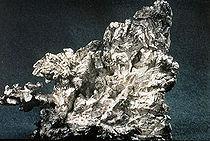|
|
Pure silver is nearly white, lustrous, soft, very ductile, malleable, it is an excellent conductor of heat and electricity. It is not a chemically active metal, but it is attacked by nitric acid (forming the nitrate) and by hot concentrated sulfuric acid. It has the highest electrical conductivity of all metals, but its greater cost has prevented it from being widely used for electrical purposes. Silver is almost always monovalent in its compounds, but an oxide, a fluoride, and a sulfide of divalent silver are known. It does not oxidize in air but reacts with the hydrogen sulfide present in the air, forming silver sulfide (tarnish). This is why silver objects need regular cleaning. Silver is stable in water. Applications The principal use of silver is as a precious metal and its halide salts, especially silver nitrate, are also widely used in photography. The major outlets are photography, the electrical and electronic industries and for domestic uses as cutlery, jewellery and mirrors. |
http://www.lenntech.com/periodic/elements/ag.htm
